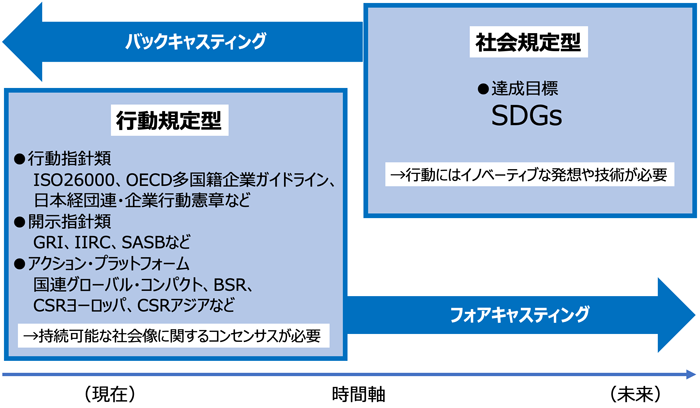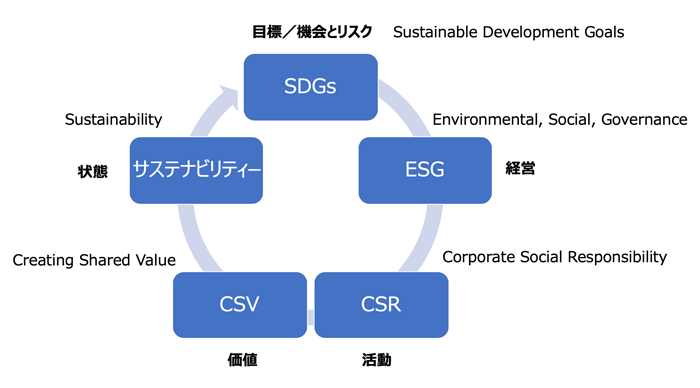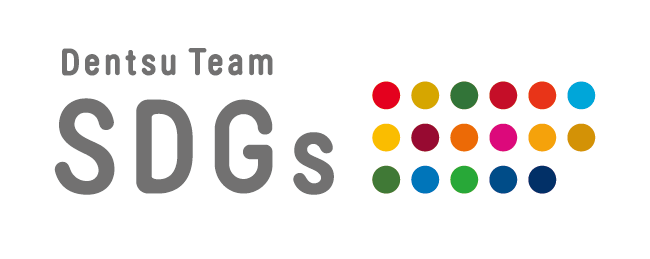How can companies integrate the SDGs into their management?
This series explores hints for achieving the SDGs through interviews with various experts and practitioners.
What changes have occurred in corporate initiatives since the adoption of the SDGs? How should companies communicate their SDG activities?
This time, we spoke with Koichi Kaneda, who promotes ESG management and CSR activities at his company.

He became the sustainability officer to engage in human development in developing countries.
──Mr. Kaneda, you've had a diverse career and now work as a corporate sustainability officer. What has your career path been like?
Kaneda: For about ten years after graduating university, I worked at Sony and the U.S. Embassy. While changing workplaces and sectors, I was responsible for government relations primarily with the Japanese government, focusing on the Ministry of Foreign Affairs and the Ministry of International Trade and Industry (now the Ministry of Economy, Trade and Industry).
Meanwhile, around the time I joined the U.S. Embassy, I began investing in myself outside of work hours to broaden my career possibilities.
I had a childhood dream of becoming an announcer. I was training at the Nippon Television Announcer College (now Nippon Television Academy), which offered weekend courses at the time. Timing worked out perfectly, and Bloomberg Television approached me. I worked as an announcer for their CS broadcast channel for two years, covering economic and corporate news.
After rejoining Sony in 1999, I have spent over 20 years to date working in sustainability roles across five companies.
──Could you tell us specifically what sparked your interest in sustainability?
Kaneda: The turning point for my shift into sustainability came during my graduate studies at the University of Reading in the UK while at Sony. There, I became fascinated by "human development in developing countries by multinational corporations."
In fact, alongside my training at the Announcement College, I systematically studied international cooperation outside of working hours at multiple training institutions, including the Foundation for International Cooperation and Development (FASID) and the Overseas Consultants Association (ECFA).
I also traveled to developing countries like Thailand and Cambodia to participate in development programs organized by NGOs, seeking to experience the reality of human development firsthand.
During this time, a former supervisor at Sony approached me with an offer to return to the company and work in the Social Contribution Office handling community relations. This marked the start of my career as a sustainability officer, where I could practically implement "human development in developing countries by multinational corporations" as part of my job.
Viewing the SDGs as a reference list of potential "opportunities and risks"
──What kind of work are you currently engaged in at NTT DATA?
Kaneda: NTT DATA explicitly stated in its 2019-21 mid-term management plan that it would contribute to achieving the SDGs through ESG management, which considers Environment, Social, and Governance factors.
In line with this, we also reviewed our CSR materiality issues for the first time in five years and set 12 priority issues to tackle. We are currently developing KPIs to address these issues.
I am involved in this series of activities. My primary responsibilities include communicating with Keidanren, which supports corporate SDG initiatives; developing programs with NGOs/NPOs that deeply understand domestic and international social issues; and promoting the internal adoption of ESG management and CSR activities utilizing the SDGs.

──Mr. Kaneda, you have been active in sustainability since before the SDGs were adopted in 2015. How did the emergence of the SDGs change corporate ESG management/CSR activities?
Kaneda: Before the SDGs were adopted, the mainstream approach toward a sustainable society was "action-prescriptive." This involved forecasting feasible actions based on past experience and following guidelines or action programs.
While individual methods of engagement were outlined, a shared vision of a sustainable society and common goals to achieve it remained vague. Companies tended to set their own easily achievable targets, and the international community as a whole lacked a sense of unity toward solving global challenges.
In contrast, the SDGs emerged as a "society-prescriptive" approach, clearly defining a societal vision through 17 goals and 169 targets. By sharing the 2030 goals and societal vision across the entire international community, companies gained the freedom to engage in activities using innovative ideas and new technologies, working backwards from that vision.
The coexistence of action-prescriptive and society-prescriptive approaches has, I believe, increased the likelihood of achieving a sustainable society.

Furthermore, in Japan, since 2003—often called the first year of CSR—various related concepts like ESG, CSV, and sustainability have dominated media coverage. With each new concept, many voiced concerns that "internal understanding couldn't keep pace, hindering the advancement of activities."
However, the advent of the SDGs, which present goals to be achieved and a vision of society to be realized by 2030, has made it possible to simplify and clarify the relationships between these concepts.
──Could you elaborate on what you mean?
Kaneda: I came to see each concept as part of a sequential process toward building a sustainable society and sustainable companies. Since this can be explained as a loop with the SDGs as both the starting point and endpoint, I call it the "SDGs Loop."

SDGs (Sustainable Development Goals)
We utilize the SDGs as a reference list for the "opportunities and risks" our company will face by 2030. The SDG Loop begins by considering how to transform our business model by referencing the SDGs.
ESG (Environmental, Social, Governance)
After considering the SDGs, what specific "management" practices should be implemented? ESG is a concept that outlines the key aspects to "consider" in management, grouped under the broad categories of Environment, Society, and Governance.
ESG management encompasses more than just sincere "consideration" within a company's own business processes or value chain—such as avoiding complicity in environmental destruction or human rights violations. It also includes revenue-generating businesses that "consider" ESG, namely:
CSR (Corporate Social Responsibility)
CSR is the concept that explains what specific "activities" are undertaken while "considering" ESG aspects.
CSR activities consist of three elements: ① Activities to provide products and services that contribute to solving social issues to the market; ② Activities to reduce the burden on society in areas such as human rights and the environment within business processes; ③ Social contribution activities, typically represented by donations and volunteer work.
Some may resist viewing the market provision of products and services that contribute to solving social issues (①) as part of CSR activities. However, faced with increasingly severe global social challenges, society's expectations of companies grow annually, significantly raising the bar for corporate responsibility. Activity ① can be considered an integral part of CSR activities, representing "activities a company should naturally undertake."
CSV (Creating Shared Value)
CSV represents the shared "value" created by companies through such CSR activities—that is, both social value and corporate value. While some argue that only activities providing products or services that contribute to solving social issues (①) should be considered CSV, here we interpret CSV literally as "value."
Activities that reduce the burden on society (②) create not only social value but also corporate value by reducing resource consumption, logistics costs, procurement expenses, and employee healthcare costs. Similarly, donations and volunteer activities (③) contribute to corporate value creation by enhancing competitiveness through the formation of clusters that include business partners, research institutions like universities, and NGOs/NPOs that understand social issues, beyond just generating social value. Activities that create shared value are not exclusive to ①; they also apply to ② and ③. However, ① represents the activities that generate the highest CSV, where innovative ideas and digital technology are expected to play a significant role.
Sustainability
Sustainability is the concept that explains what "state" society and companies will be in once CSV is created. If society and companies achieve a sustainable state, this will bring us closer to achieving the 2030 "goals" set forth by the SDGs.
This approach, organizing the five concepts through the steps "Opportunities and Risks (SDGs) → Management (ESG) → Activities (CSR) → Value (CSV) → State (Sustainability) → Goals (SDGs)," is called the "SDGs Loop."
We need advertising to increase the number of people involved in the SDGs
──Mr. Kaneda, you're also involved in external communications, such as facilitating a session themed on solving social issues through digital technology at a conference hosted by NTT DATA.
Additionally, you will serve as the chairperson for the selection committee of the "SDGs Special Award" at this year's Advertising Dentsu Inc. Awards, which honors works that sincerely explore what advertising can do to achieve the SDGs. Could you share key points for companies communicating about the SDGs?
Kaneda: Let's consider communication as two distinct activities: "reporting" and "advertising." Transparently disclosing messages and examples like "This is how our company views the SDGs" or "These are the initiatives we are undertaking" through our company website and sustainability reports—this kind of "sustainability reporting" is, of course, crucial for achieving the SDGs.
On the other hand, the "collaboration" phase requires working together with people from different sectors and diverse ideas and talents to achieve the SDGs.
"Advertising," with its persuasive function, can become an effective means of collective impact, directing people toward "collaboration" for building a sustainable society. Companies, as advertisers, can also enhance their corporate value through excellent "sustainability advertising."
Therefore, in selecting the "SDGs Special Award," we intend to evaluate not only whether the work has internalized and expressed the key messages proposed by the SDGs in its own way, but also whether it possesses unique mechanisms and creativity that prompt viewers to perceive the SDGs as personally relevant and take action towards realizing a sustainable society.

TeamSDGs collaborates with various SDGs stakeholders to disseminate information about the SDGs and plan/develop solutions.
※Please also see Koichi Kaneda's article here:
Sustainability Manager Koichi Kaneda Discusses What is Now Required of Japanese Companies' SDGs Initiatives
Was this article helpful?